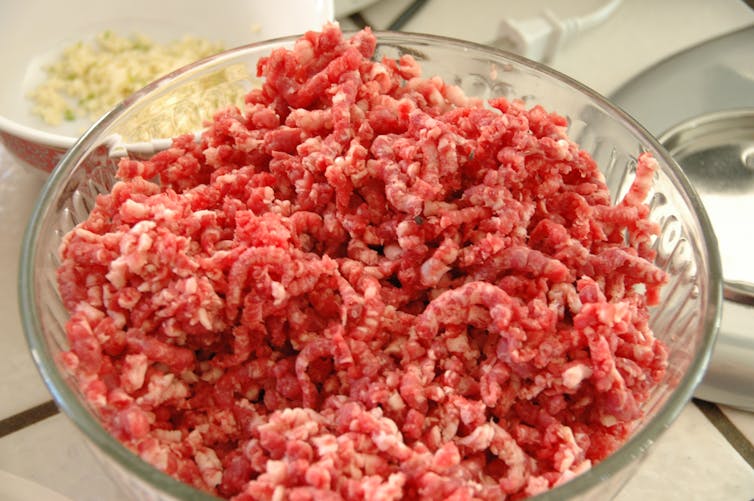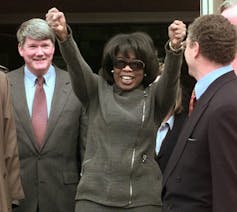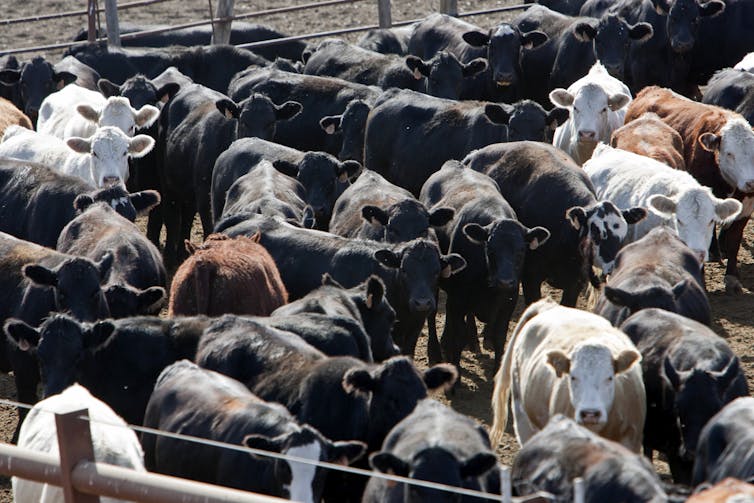Oprah Winfrey Talks Bad About Beef
20 years ago, images of staggering cattle and descriptions of brains resembling Swiss cheese became associated with one of the most popular television programs of the day when Texas Panhandle cattlemen sued "The Oprah Winfrey Show" for defamation under Texas' "veggie libel constabulary." They claimed the program's negative portrayal of their business caused a steep decline of beef prices.
On the surface, this conflict looked similar a battle betwixt an industry and the Television set producers who portrayed it negatively. But at its centre was some complicated science that had the potential to scare the public and be sensationalized by the media.
Today's practitioners of science communication grapple with the difficulty of transmitting science information via the media to a lay audience. This 1998 trial serves equally a rare public case study documenting the media'southward imperfect attempts to clarify the science of mad cow affliction in the midst of a celebrity spectacle.
Ultimately Oprah won the legal case. Only how did the public'southward understanding of the science fare?
Facts of the case
A year and a one-half earlier, rancher-turned-fauna-rights activist Howard Lyman appeared on Winfrey's program. He claimed the American beef industry was giving cattle feed that contained remains of candy cattle. This practise, no longer legal in the U.S., had been banned by the British authorities in 1996 due to the belief it had led to the 1980s outbreak in Peachy Britain of bovine spongiform encephalopathy.
BSE is a fatal nervous arrangement disease in cattle; a human form of the disease, Creutzfeldt-Jakob, was subsequently diagnosed in England, causing the deaths of 178 people in the U.K. through 2017. Medical researchers believed this grade of CJD was acquired past eating the meat of cattle infected with BSE.
Upon hearing these revelations Winfrey proclaimed on-air, "Information technology has just stopped me common cold from eating another burger!" The "Oprah effect" kicked into gear and the term "mad cow illness" rose in the public consciousness.
The resulting lawsuit initially focused on the science of BSE and the extent of the danger to beef consumers. However, the judge'southward ruling ultimately hinged on legal questions of freedom of speech, rather than whether "The Oprah Winfrey Show" circulate scientifically valid findings.

Science from lawyers, via media, to public
The verdict itself doesn't provide a articulate reflection of how effectively the scientific discipline of BSE had been communicated during the trial to the jury. But the case was besides tried, equally they say, in the courtroom of public opinion.
U.S. District Judge Mary Lou Robinson imposed a gag order on the attorneys, prohibiting them from talking about the instance outside of court. She did, however, provide permanent seats in the Amarillo court for local media. One of usa (Larry Lemmons) was the atomic number 82 reporter for the local CBS affiliate during the trial.
Celebrity sightings around the courthouse were common. PETA protesters traded insults with local eating place employees grilling burgers for the crowd. Presumably because I was 1 of the primary local media reporters, my reports were followed by attorneys from both sides. When I personally met Oprah Winfrey she remarked, "And then you're Larry Lemmons." I never figured out precisely what that meant.
My media colleagues and I struggled to understand and communicate the specifics of BSE. Nosotros listened to the attorneys present the science to the jury, and then communicated those details to the public, who tended to exist more than interested in the spectacle.
In Amarillo in 1998, although access to the internet was growing more mutual, we reporters tended to regard it with suspicion. We gathered news the old-fashioned mode, via in-person or phone interviews. For BSE research, I went to the library and a local college where a science professor provided me with some groundwork. Office of my task as a reporter was to become the complicated scientific facts directly, and I couldn't ask any of the trial participants for clarification.
Looking back over two decades, I wondered if my challenges communicating the science were shared by colleagues and other of import players in the trial. Now, as a doctoral student of media and communication (working with Dr. Landrum and others at Texas Tech), I contacted some of them to hash out how attorneys related the scientific discipline of BSE to the jury and how the media afterward reported on information presented in the court.
Thinking back to the trial

Every bit expected, in that location are alien perspectives on how effectively the science was communicated.
Howard Lyman's defense attorney, Barry Peterson, said that "to prevail I had to inform the jury that at that place was reasonable scientific show to support Howard'due south opinions." But he likewise had to consider the political surround: "We were more concerned about our ability to successfully defend Howard and HARPO Product because we are in beef country."
Despite representing the losing side, 1 of the plaintiff's attorneys Vince Nowak said the trial was a success for the cattle industry because it convinced the public that BSE was not a serious threat to American livestock. Though he presented extensively on the science during the trial, he acknowledged that "science played a very small factor" in the subsequent ruling past the judge.
Nevertheless, some reporters said the local cattle industry, who were not affected by the judge'due south gag society, should accept been more eager to clarify to the media the relative risks of Texas cattle becoming infected with BSE. At the time, Kay Ledbetter worked for the Amarillo World-News. She said obtaining scientific information was frustrating and limited to what was discussed in the courtroom:
"There was nobody reliable to discuss what the affliction – bovine spongiform encephalopathy – really was … We were left with the catch phrase Mad Cow Affliction, and our imagination."
On the other hand, Stacy Yates, who covered the trial for local news radio station KGNC, idea both the defense and plaintiffs did a reasonable task communicating the science and that "if you were a person who wanted to understand the scientific discipline, the coverage was there."
Ultimately the media roofing this trial were left to muddle through equally best we could – and the public relied on our efforts.

The name matters
My own notes from the trial are rich with legal and scientific explanations that accompanied courtroom observations. Notes for ane written report included this passage:
"[Winfrey's] attorney Charles Babcock tried to constitute links between what'southward called 'new variant CJD' in humans and mad cow disease in cattle. [Chief plaintiff Paul] Engler insisted upon precise scientific answers while Babcock tried to put the issue in layman'south terms."
However, recent research on how to nearly effectively communicate science has found that sometimes putting a scientific issue into less accurate layman's terms can add to confusion and heighten controversy.
Ledbetter is at present an agriculture science communicator for Texas A&M AgriLife, a statewide agricultural research establishment. She said that by using the term "mad moo-cow illness," the media misrepresented the issue:
"It's not Mad Cow Disease, it'southward bovine spongiform encephalopathy or BSE. And if agriculture would accept taken the same opinion on this outcome every bit they did on Swine Flu, trying to educate on what it really was and asking the media to call information technology past its real name, H1N1, many people wouldn't have had the aforementioned concerns."
Ledbetter'southward point of view is supported past science communication enquiry. In i study, researchers investigating a subsequent mad cow outbreak in France determined that the framing of the issue influences public perception. When people were confronted with the term "mad cow," they reacted more emotionally than they did to a scientific label, such every bit BSE. It's an open up question, though, how opinion would have changed with the use of a more deliberative clarification of the disease during the Oprah Winfrey lawsuit.
Today the CDC considers the risks to Americans from BSE to be "extremely low." Since 1993 at that place accept been a total of only 25 cases of BSE in North American cattle, the majority of those in Canada. In "A Comparative Study of Communication Almost Nutrient Rubber Before, During, and Later on the 'Mad Cow' Crisis," food police force scholar Matteo Ferrari concluded the public decides whom to trust regarding the message by how government, industry or advocates frame information technology.
In this example, the jury determined the media's Start Amendment protections outweighed the defamation concerns presented by the plaintiffs. Ironically, because of the media focus on the trial, the perspectives of the cattle manufacture were likewise highlighted.
The public got the bulletin that there was petty evidence that BSE threatened American livestock in a substantial way. Two decades of hindsight advise that lawyers and media – in perhaps a piecemeal, stumbling manner – did transmit relatively accurate science information. The cattlemen may have lost the case, but U.S. media consumers were left with the understanding that U.S. beef was rubber. Media professionals nevertheless struggle with knowing how to best explicate and condense complex science and public health problems in means that won't inappropriately trigger defensiveness, denial or fear. Research in the expanse of the science of scientific discipline advice has made not bad strides in exploring these problems, simply at that place is still much work to be done.
Source: https://theconversation.com/mad-cows-oprah-winfrey-and-communicating-the-science-in-a-high-profile-court-case-91814
0 Response to "Oprah Winfrey Talks Bad About Beef"
Post a Comment